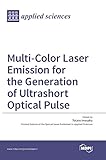Multi-Color Laser Emission for the Generation of Ultrashort Optical Pulse
Material type: ArticleLanguage: English Publication details: MDPI - Multidisciplinary Digital Publishing Institute 2017Description: 1 electronic resource (XXII, 192 p.)ISBN:
ArticleLanguage: English Publication details: MDPI - Multidisciplinary Digital Publishing Institute 2017Description: 1 electronic resource (XXII, 192 p.)ISBN: - 9783038422822
Open Access star Unrestricted online access
The pulse width of an electromagnetic wave is determined by the frequency band width of the wave used. Therefore, one femtosecond is the ultimate in pulse width for an “optical” wave. For this reason, several methods have been proposed for the generation of an ultrashort optical pulse. For example, resonance/non-resonance four-wave mixing would be one of the candidates for generating multi-color laser emission in an extremely wide spectral region, thus breaking the 1-fs barrier. To date, numerous emission lines have been generated from the deep-ultraviolet to the near-infrared region (<45,000 cm−1). Such generations use a variety of techniques, such as four-wave Raman mixing in molecular hydrogen. This type of technique is promising for the generation of 1-fs optical pulses via phase locking and the Fourier synthesis of the emission lines. For verification, it would be necessary to develop a new method for measuring the pulse width, since the spectral band width approaches, or is beyond one octave. Ultrashort optical pulses can be utilized in a variety of applications in science and technology. For example, an ultrashort optical pulse can be used in the studies of ultrafast phenomena. More practically, a laser pulse shorter than 100 fs is reported to be useful in mass spectrometry for observing a molecular ion of triacetone triperoxide, an explosive used in terrorist attacks. A train of ultrashort optical pulses in the terahertz region, which has been generated in the optical cavity to enhance the nonlinear optical effect, would be employed as a clock pulse in optical computation/communication in future advanced industries. Therefore, it is important to investigate a new frontier in the generation of multi-color laser emission for Fourier synthesis to generate ultrashort optical pulses and to clarify new trends in the state-of-the-art.
Creative Commons https://creativecommons.org/licenses/by-nc-nd/4.0/ cc https://creativecommons.org/licenses/by-nc-nd/4.0/
English
There are no comments on this title.

